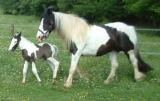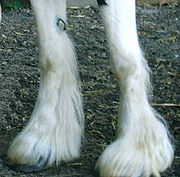
Gypsy Vanner horse
Encyclopedia
The Gypsy Horse also known as an Irish cob (Ireland/UK), Gypsy Cob, Gypsy Vanner (USA), Coloured Cob (UK/Ireland) or Tinker horse (Europe), is a horse breed
. The breed originates from the UK and Ireland. Members of the breed come in a variety of colours but predominantly are of piebald colouring and have many draft characteristics, including heavy bone and abundant feathering
on the lower legs. There is no exact known history of the Gypsy Cob. It is believed by some that the Gypsy Cobs are descended from a combination of Shires
, Clydesdales, Friesians
, and Dales Ponies
with their origins in the Romani gypsy community of the United Kingdom
.
 There is no set color standard for Gypsy Cobs, although the breed is often piebald in colouring. In the United Kingdom, patterns consisting of patches of black and white are traditionally called piebald
There is no set color standard for Gypsy Cobs, although the breed is often piebald in colouring. In the United Kingdom, patterns consisting of patches of black and white are traditionally called piebald
, and patches of any other colour with white are called skewbald
. The Gypsy Vanner typically has an abundant mane
and tail
as well as "feather" or "feathering" on the legs, long hair starting at the cannon bone and flowing down over the hooves
.
The build is powerful and compact, with a short neck and back. The Gypsy cob is heavy boned, the typical horse measuring between . There is no height limit in the registry. The cannon circumference can range from 8" to 12". The chest is broad with well sprung ribs, the hips are heavy, they have short backs, strong shoulders, and the withers are rounded. The hair should be straight and silky, kinky hair is a fault. Their legs should have heavy bone set on large hooves, their hind legs should not be too straight. Gypsy Vanners must also have excellent endurance, and be able to go long distances without tiring. Up until the late 20th century, the Gypsy Cob was not a recognized breed. Not much is known about the bloodlines of Gypsy Cobs because pedigree
s were usually kept secret and only family members knew the details. However, as the interest in the breed grew, several breed registries developed. The first registered horses were imported to North America
in November 1996. There are three different registry classifications for the breed in the US, based on height. If the horse is under , it is considered to be a "mini Gypsy". If the horse is 14-15.2 hands high, it is known as a "classic Gypsy", and if the breed is 15.2 or taller, it is known as a "grand Gypsy". In 2004, the breed became recognized by the United States Dressage Federation
All Breeds Program, and can win breed-specific awards whenever it wins a dressage
event or any event sponsored by the USDF.

horse. These horses were bred by the Romany, and pulled wagons or "caravans" known as Vardos
, which is a type of covered wagon
that people sometimes lived in. They were also used as riding horses for children. Today, the Gypsy Cob is no longer used for pulling Vardos, but it is still looked upon as a symbol of power and strength among the Romany
Horse breed
Horse breed is a broad term with no clear consensus as to definition, but most commonly refers to selectively bred populations of domesticated horses, often with pedigrees recorded in a breed registry. However, the term is sometimes used in a very broad sense to define landrace animals, or...
. The breed originates from the UK and Ireland. Members of the breed come in a variety of colours but predominantly are of piebald colouring and have many draft characteristics, including heavy bone and abundant feathering
Feathering (horse)
Feathering, or feather, is a term used to describe the long hair on the lower legs and fetlocks of some breeds of horse and pony. On some horses, especially draft breeds, the hair can almost cover the hooves...
on the lower legs. There is no exact known history of the Gypsy Cob. It is believed by some that the Gypsy Cobs are descended from a combination of Shires
Shire horse
The Shire horse is a breed of draught horse or draft horse . The breed comes in many colours, including black, bay and grey. They are a tall breed, with mares standing and over and stallions standing and over. The breed has an enormous capacity for weight pulling, and Shires have held the world...
, Clydesdales, Friesians
Friesian horse
The Friesian is a horse breed originating in Friesland, Netherlands. Although the breed's conformation resembles that of a light draft horse, Friesians are graceful and nimble for their size. During the Middle Ages, it is believed that the ancestors of Friesian horses were in great demand as war...
, and Dales Ponies
Dales Pony
-External links:****...
with their origins in the Romani gypsy community of the United Kingdom
United Kingdom
The United Kingdom of Great Britain and Northern IrelandIn the United Kingdom and Dependencies, other languages have been officially recognised as legitimate autochthonous languages under the European Charter for Regional or Minority Languages...
.
Characteristics

Piebald
A piebald or pied animal is one that has a spotting pattern of large unpigmented, usually white, areas of hair, feathers, or scales and normally pigmented patches, generally black. The colour of the animal's skin underneath its coat is also pigmented under the dark patches and unpigmented under...
, and patches of any other colour with white are called skewbald
Skewbald
Skewbald is a color pattern of horses. A skewbald horse has a coat made up of white patches on a non-black base coat, such as chestnut, bay, or any color besides black coat. Skewbald horses which are bay and white are sometimes called tricoloured...
. The Gypsy Vanner typically has an abundant mane
Mane (horse)
The mane is the hair that grows from the top of the neck of a horse or other equine, reaching from the poll to the withers, and includes the forelock or foretop. It is thicker and coarser than the rest of the horse's coat, and naturally grows to roughly cover the neck...
and tail
Tail (horse)
The tail of the horse and other equines consists of two parts, the dock and the skirt. The dock consists of the muscles and skin covering the coccygeal vertebrae. The term "skirt" refers to the long hairs that fall below the dock...
as well as "feather" or "feathering" on the legs, long hair starting at the cannon bone and flowing down over the hooves
Horse hoof
A horse hoof is a structure surrounding the distal phalanx of the 3rd digit of each of the four limbs of Equus species, which is covered by complex soft tissue and keratinised structures...
.
The build is powerful and compact, with a short neck and back. The Gypsy cob is heavy boned, the typical horse measuring between . There is no height limit in the registry. The cannon circumference can range from 8" to 12". The chest is broad with well sprung ribs, the hips are heavy, they have short backs, strong shoulders, and the withers are rounded. The hair should be straight and silky, kinky hair is a fault. Their legs should have heavy bone set on large hooves, their hind legs should not be too straight. Gypsy Vanners must also have excellent endurance, and be able to go long distances without tiring. Up until the late 20th century, the Gypsy Cob was not a recognized breed. Not much is known about the bloodlines of Gypsy Cobs because pedigree
Pedigree chart
A pedigree chart is a diagram that shows the occurrence and appearance or phenotypes of a particular gene or organism and its ancestors from one generation to the next, most commonly humans, show dogs, and race horses....
s were usually kept secret and only family members knew the details. However, as the interest in the breed grew, several breed registries developed. The first registered horses were imported to North America
North America
North America is a continent wholly within the Northern Hemisphere and almost wholly within the Western Hemisphere. It is also considered a northern subcontinent of the Americas...
in November 1996. There are three different registry classifications for the breed in the US, based on height. If the horse is under , it is considered to be a "mini Gypsy". If the horse is 14-15.2 hands high, it is known as a "classic Gypsy", and if the breed is 15.2 or taller, it is known as a "grand Gypsy". In 2004, the breed became recognized by the United States Dressage Federation
United States Dressage Federation
The United States Dressage Federation, or the USDF, is the national membership federation for the equestrian sport of dressage. Running under the USEF, the Federation is committed to education, recognition of achievement and promotion of dressage in the United States.Founded in 1973, the USDF now...
All Breeds Program, and can win breed-specific awards whenever it wins a dressage
Dressage
Dressage is a competitive equestrian sport, defined by the International Equestrian Federation as "the highest expression of horse training." Competitions are held at all levels from amateur to the World Equestrian Games...
event or any event sponsored by the USDF.

History
The Gypsy Cob was bred to be a wagonWagon
A wagon is a heavy four-wheeled vehicle pulled by draught animals; it was formerly often called a wain, and if low and sideless may be called a dray, trolley or float....
horse. These horses were bred by the Romany, and pulled wagons or "caravans" known as Vardos
Vardo (gypsy wagon)
A vardo is a traditional horse-drawn wagon used by British Romani people .The design of the vardo included large wheels running outside the body of the van, which slopes outwards considerably towards the eaves...
, which is a type of covered wagon
Wagon
A wagon is a heavy four-wheeled vehicle pulled by draught animals; it was formerly often called a wain, and if low and sideless may be called a dray, trolley or float....
that people sometimes lived in. They were also used as riding horses for children. Today, the Gypsy Cob is no longer used for pulling Vardos, but it is still looked upon as a symbol of power and strength among the Romany

